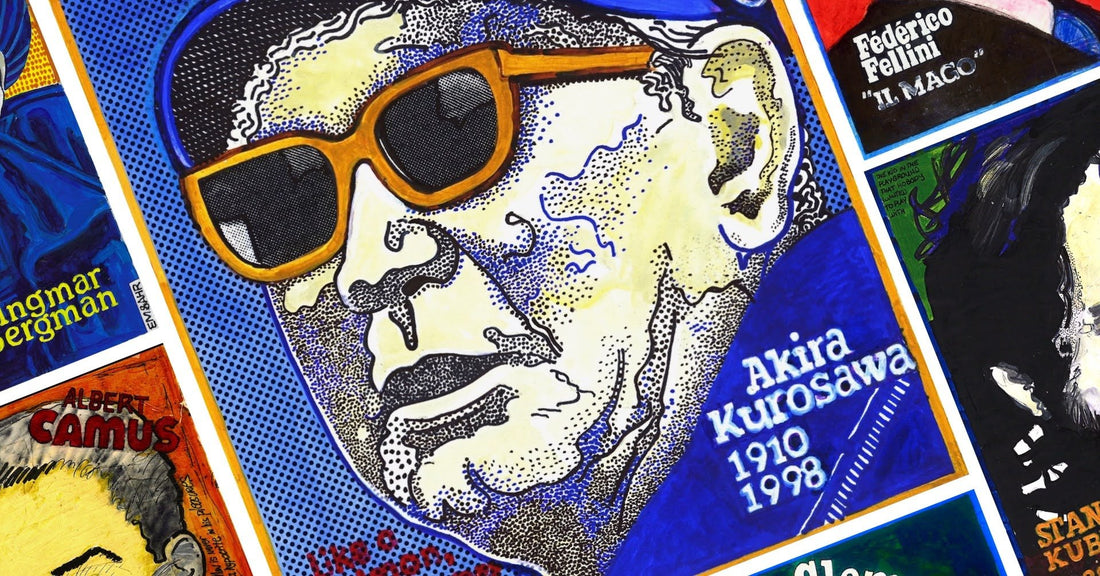
Akira Kurosawa: The Director Who Bridged Worlds
Share
Akira Kurosawa, born on March 23, 1910, in Tokyo, Japan, grew up in a nation at a cultural crossroads. Trained as a painter before entering the world of film, his artistic eye shaped everything he touched. That background in visual art became his foundation—his films looked like living paintings, every frame deliberate, layered, and alive.
What set Kurosawa apart was not just his storytelling but his unmatched command of cinematic technique. He revolutionized camera movement, often using multiple cameras to capture scenes from various angles, creating dynamic edits that gave his films a sense of immediacy and motion. He pioneered the wipe transition, a now-classic visual cut later adopted by filmmakers like George Lucas in Star Wars. His use of telephoto lenses compressed depth to make crowds feel chaotic and battles more intense, while his famous “axial cuts” shifted perspective along a single line to emphasize emotion or action.
Weather was never a backdrop for Kurosawa—it was a character. In Rashomon, rain became a metaphor for uncertainty; in Seven Samurai, storms turned battles into desperate struggles for survival. He made nature a living participant in the drama, heightening mood and tension with the environment itself.
Narratively, Kurosawa was a master of human complexity. He explored honor, morality, and the shades of truth that lie between heroism and selfishness. Rashomon challenged viewers with multiple perspectives of the same event, forever changing how stories could be told. Seven Samurai laid the foundation for the “assembled team” trope, inspiring everything from The Magnificent Seven to modern superhero films.
His influence rippled globally. George Lucas credited The Hidden Fortress as a key inspiration for Star Wars, from its plot structure to its humble, observer-like characters reminiscent of C-3PO and R2-D2. Sergio Leone borrowed from Kurosawa’s Yojimbo to craft A Fistful of Dollars, shaping the spaghetti western genre.
Despite his genius, Kurosawa faced deep personal and professional struggles. In the 1970s, a series of box office failures left him isolated and depressed, culminating in a suicide attempt. Yet, like many of his characters, he rose again. With Kagemusha and Ran, he created late-career masterpieces that showcased his resilience and ability to adapt without compromising his vision.
Kurosawa passed away on September 6, 1998, leaving behind more than just a catalog of films—he left a cinematic language. From sweeping epics to intimate dramas, his techniques continue to guide directors on how to frame a story, how to use nature to intensify emotion, and how to explore humanity with honesty and grandeur.
He was not only a director—he was a poet of motion, a painter of time, and a storyteller whose legacy continues to shape the art form itself. Every heroic ensemble, every mythic journey, and every daring camera move carries a trace of Kurosawa’s spirit.

Here’s a list of modern directors deeply influenced by Akira Kurosawa and how his techniques shaped their work:
1. George Lucas
Connection: Star Wars drew heavily from Kurosawa’s The Hidden Fortress, particularly in its narrative structure (telling an epic through the eyes of minor characters) and visual style.
Influence: The wipe transitions, Jedi’s samurai-inspired philosophy, and the lone hero archetype echo Kurosawa’s storytelling.
2. Steven Spielberg
Connection: Spielberg often cited Kurosawa as a mentor figure and even collaborated with him financially to help produce Kagemusha.
Influence: His mastery of movement within the frame and his ability to combine intimate moments with sweeping spectacle can be traced back to Kurosawa’s style.
3. Martin Scorsese
Connection: Scorsese appeared in Kurosawa’s Dreams (as Vincent van Gogh) and revered him as one of the greatest directors of all time.
Influence: His dynamic camera movement, use of weather for mood, and exploration of human flaws have Kurosawa’s fingerprints.
4. Quentin Tarantino
Connection: Tarantino borrowed Kurosawa’s samurai-inspired aesthetics for Kill Bill and used his editing rhythms to heighten tension.
Influence: The concept of honor among violent chaos, as seen in Kurosawa’s Yojimbo, resonates throughout Tarantino’s work.
5. Francis Ford Coppola
Connection: Alongside Lucas, Coppola helped bring Kurosawa’s Kagemusha to life financially.
Influence: His epic storytelling and ensemble-driven dramas (The Godfather, Apocalypse Now) bear similarities to Kurosawa’s layered narratives.
6. Christopher Nolan
Connection: Though more subtle, Nolan has acknowledged Kurosawa’s influence in the use of time, perception, and moral ambiguity.
Influence: Films like Inception and The Dark Knight borrow the multi-perspective storytelling style first popularized by Rashomon.
7. Zack Snyder
Connection: Snyder openly credited Kurosawa for inspiring the slow-motion battle dynamics in 300 and Watchmen.
Influence: The use of natural elements (dust, rain, wind) in his action scenes mirrors Kurosawa’s environmental intensity.
